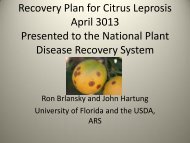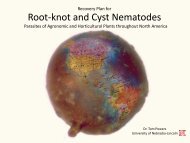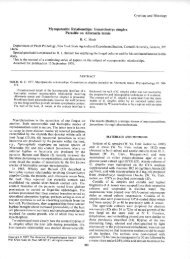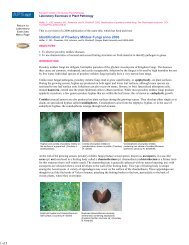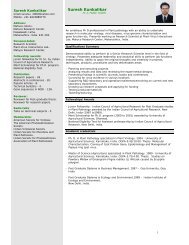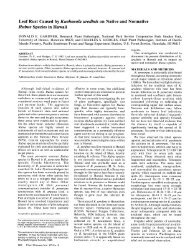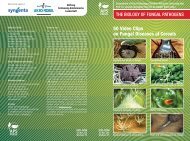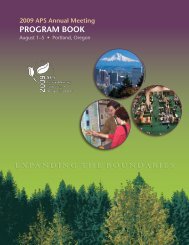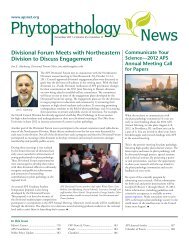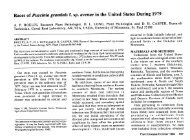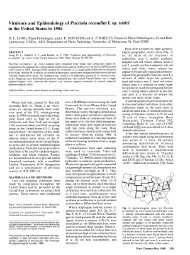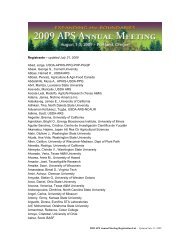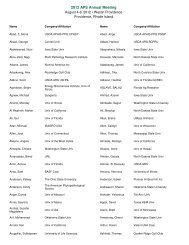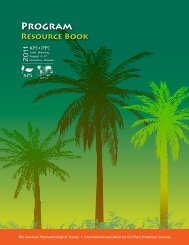view article - American Phytopathological Society
view article - American Phytopathological Society
view article - American Phytopathological Society
Create successful ePaper yourself
Turn your PDF publications into a flip-book with our unique Google optimized e-Paper software.
54 58<br />
YIELD CONSTRAINTS IN WHEAT DUE TO SOILBORNE PATHOGENS. PERSPECTIVES OF DISEASE THREAT IN LARGE-SCALE PINUS RADIATA<br />
E.A. Milus and C.S. Rothrock, Dept. of Plant Pathology, MONOCULTURE -THE NEW ZEALAND EXPERIENCE. C.K.S.Chou, Forest<br />
University of Arkansas, Fayetteville, AR 72701. Research Institute, Rotorua, New Zealand.<br />
About 95% of New Zealand wood production today comes from exotic<br />
The importance of soilborne pathogens as constraints to plantations (mainly Pinus radiata) .For over 6 decades this forestry<br />
wheat yield and quality in Arkansas was determined in a monoculture,now 1.1 million hahas withstood the threat of dissplit,<br />
strip plot experiment. Main plots were raised or ease. In the late 1940's 25-35% of 20-25-year-old trees (unthinned<br />
conventional seed beds. Subplots were fumigated (Bromogas stands) were killed in a Sirex-Amylostereum epidemic.However the<br />
67), metalaxyl-treated seed, and a nontreated check. Sub- economic loss was insignificant.Aerial spraying to control<br />
subplots were planted with wheat (cv. Keiser, Florida 302, Dothistroma needle blight since 1966 has cost around $14.5<br />
or Caldwell) or oats (cv. Bob). In January plants were dug million. Losses caused by other diseases, i.e.,Sphaeropsis sapinea<br />
from the ends of each plot, growth parameters were measured, Armillaria root-rot,and Cyclaneusma needle-cast, have been<br />
and the entire crown and root system plated onto water agar. locally severe but tolerable overall. The current practice of waste<br />
Fungal colonies were transferred to PDA, identified to genus, thinning 75- 8 5% of initial stockings before age 10-12 allows a high<br />
and representative isolates were tested for pathogenicity. level of acceptable loss for diseases which mainly attack young<br />
Bedded plots had twice the number of plants infected with stands, while clear-felling at age 25-30 obviates diseases that<br />
Helminthosporium sativum. Plants from fumigated plots had affect older stands.However, New Zealand still has only a few pine<br />
more tillers/plant, greater top weight, and fewer plants pathogens and with the trend towards clonal forestry, genetic uniinfected<br />
with Pythium, Helminthosporium sativum, and formity, and reduction of initial/final crop stocking ratios,the<br />
Rhizoctonia. Pythium was the most commo .genus isolated. history of disease in this country is no way near its end.<br />
55<br />
HYPOVIRULENT STRAINS OF CRYPHONECTRIA PARASITICA IN<br />
RECOVERY<br />
NEW JERSEY.<br />
OF WHITE AND GREEN ISOLATES OF ASPERGILLUS FLAVUS P.J. Bedker. Department of Horticulture<br />
FROM<br />
and<br />
INDIVIDUAL<br />
Forestry,<br />
KERNELS<br />
Rutgers<br />
FROM DOUBLE-INOCULATED MAIZE EARS. University, New Brunswick, NJ 08903.<br />
Natale Zummo, USDA-ARS, Dept. of Plant Pathology and Weed<br />
Science, Mississippi State, MS 39762. Approximately 30 isolates of C. parasitica were collected from<br />
cankers<br />
Maize on ears were<br />
<strong>American</strong> chestnut inoculated at 4 locations. in the field The with virulence a white of<br />
each was determined by inoculating<br />
isolate of<br />
"Granny<br />
Aspergillus<br />
Smith"<br />
flavus<br />
apple<br />
at<br />
fruits.<br />
2 days after midsilk in Mean radial growth (MRG) was determined<br />
the shank or<br />
by<br />
through<br />
measuring<br />
the<br />
the<br />
husk<br />
length<br />
in the base of the cob and and width of lesions at 17 days after inoculation for 8<br />
re-inoculated 4 days later with a green isolate of the replications / isolate. Each apple was also inoculated with<br />
fungus through the husk at the top<br />
silk<br />
of the<br />
channel.<br />
ear or in the<br />
Reciprocal<br />
strain<br />
inoculations<br />
EP155 from Connecticut.<br />
were made.<br />
The MRG<br />
Ears<br />
for isolates collected<br />
from sites in Howell and Millstone Twps.<br />
were<br />
(Monmouth<br />
harvested at<br />
Co.),<br />
60 days after midsilk, dried, and Plumsted Twp. (Ocean Co.), and Sandyston Twp. (Sussex<br />
shelled. When<br />
Co.)<br />
kernels<br />
were<br />
from these double-inoculated ears 18.2, 19.1, 17.3, and 18.4 mm, respectively. The<br />
were<br />
MRG for<br />
assayed,<br />
37.5<br />
the<br />
%<br />
white isolate was recovered singly from (45/120) of the isolates was significantly<br />
8% of kernels,<br />
(P



